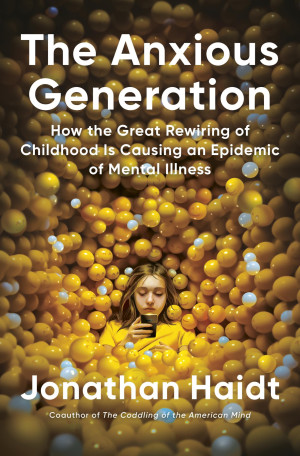Chapter 9 Preparing for Collective Action
Chapter 9
Preparing for Collective Action
The most common response I get when I say that we need to delay the age at which children get smartphones and social media accounts is “I agree with you, but it’s too late.” It has become so ordinary for 11-year-olds to walk around staring down at their phones, swiping through bottomless feeds, that many people cannot imagine that we could change it if we wanted to. “That ship has sailed,” they tell me, or “that train has left the station.” But to me, these transportation metaphors imply that we need to act right away. I’ve been on airplanes that left the gate and were then called back when a safety issue was discovered. After the Titanic sank in 1912, its two sister ships were pulled out of service and modified to make them safer. When new consumer products are found to be dangerous, especially for children, we recall them and keep them off the market until the manufacturer corrects the design.
In 2010, teens, parents, schools, and even tech companies didn’t know that smartphones and social media had so many harmful effects. Now we do. In 2010 there was little sign of a mental health crisis. Now it’s all around us.
We are not helpless, although it often feels that way because smartphones, social media, market forces, and social influence combine to pull us into a trap. Each of us, acting alone, perceives that it’s too difficult or costly to do the right thing. But if we can act together, the costs go way down.
In this short chapter, I explain what collective action problems are and I describe some of the common mechanisms used to solve them. Then, in each of the remaining chapters of part 4, I’ll show what governments, tech companies, schools, and parents can do to reverse the disastrous transition from play-based to phone-based childhood.
Collective Action Problems
Social scientists have long studied traps where each individual does what she thinks is best for herself (such as overfishing in a local pond), even though, when everyone makes the same choice, it leads to a bad outcome for all (the pond stops producing any fish). If the group could coordinate (such as by setting a limit on how many fish each resident can take), the long-term outcome would be far more fish for everyone. These traps are called collective action problems (or sometimes social dilemmas ). Preteens are trapped in a collective action problem when they arrive for their first day of sixth grade and see that some of their classmates have gotten smartphones and are connecting on Instagram and Snapchat, even during class time. That puts pressure on them to get a smartphone and social media, even though all students would be better off if none of them had these things.
Alexis Spence explained to me why she was so desperate to get an Instagram account in sixth grade, despite her parents’ prohibition:
What made it so addictive was that I just wanted to fit in with my peers. I didn’t want to miss anything, because if I missed anything, then I was out of the loop, and if I was out of the loop, then kids would laugh at me or make fun of me for not understanding what was going on, and I didn’t want to be left out.
Once a few students get smartphones and social media accounts, the other students put pressure on their parents, putting them into a trap as well. It’s painful for parents to hear their children say, “ Everyone else has a smartphone. If you don’t get me one, I’ll be excluded from everything .” (Of course, “everyone” may just mean “some other kids.”) Few parents want their preteens to disappear into a phone, but the vision of their child being a social outcast is even more distressing. Many parents therefore give in and buy their child a smartphone at age 11, or younger. As more parents relent, pressure grows on the remaining kids and parents, until the community reaches a stable but unfortunate equilibrium: Everyone really does have a smartphone, everyone disappears into their phones, and the play-based childhood is over.
Because technology adoption happens so quickly in the digital world, some of the tech companies find themselves in a collective action problem too. They need to act fast and recruit as many children and teens as possible. Never mind that their own policies and U.S. law require that users be 13 or older; any company that truly verifies the ages of its new users will lose preteens to their competitors, who have no qualms about illegally fishing for underage users.
Parents face collective action problems around childhood independence too. It was easy to send kids out to play back when everyone was doing it, but in a neighborhood where nobody does that, it’s hard to be the first one. Parents who let their children walk or play unchaperoned in a public place face the risk that a misguided neighbor will call the police, who may refer the case to Child Protective Services, who’d then investigate them for “neglect” of their children. Each parent decides that it’s best to do what every other parent is doing: Keep kids supervised, always, even if that stunts the development of all children.
How do we escape from these traps? Collective action problems require collective responses. There are four main types of collective response, and each can help us to bring about major change:
Voluntary coordination . Just as parents put additional pressure on the holdouts when they give their 11-year-old a smartphone, parents can support each other when they stick together. The group Wait Until 8th is a wonderful example of such coordination: Parents sign a pledge when their child is in elementary school that they will not give their child a smartphone until eighth grade. The pledge becomes binding only when 10 families with kids in that school and grade sign the pledge, which guarantees that those children will have others to play with and will not feel that they are the “only ones” excluded. The trap is broken and those 10 families escape together (although only until eighth grade, which is too early because it is still in middle school. I wish they would change their name to Wait Until 9th).
Social norms and moralization. A community can come to see a personal decision in moral terms and express its revulsion or condemnation, as has happened toward drunk driving (fortunately) or toward a mother who lets her 9-year-old son ride the subway without an adult chaperone (unfortunately). [1] We can reverse the negative moralization of childhood autonomy and come to see 9-year-olds walking around without chaperones as perfectly normal, which it was until very recently.
Technological solutions . A new product or invention can change the options and incentives for everyone in a community at the same time, such as the introduction of lockable pouches for phones, the development of quick and easy age verification methods, or the introduction of better basic phones, which would reduce the pressure on parents to give their children smartphones and social media before high school.
Laws and rules. Governments can make laws, such as requiring all social media companies to verify the ages of new users, or clarifying neglect laws so that giving independence to a child is not evidence of neglect. Institutions can set policies, such as a school requiring all students to keep their phones in phone lockers during the school day.
In the next three chapters, I will lay out a plan by which governments, tech companies, schools, parents, and young people can break out of multiple collective action problems by working together. I called on my friend and collaborator Lenore Skenazy to help me write all three chapters. Lenore is the author of the 2009 book Free-Range Kids , [2] which my wife and I read in 2012. It changed the way we raised our children. We gave them independence earlier, which in turn gave them more confidence in themselves, which in turn gave us more confidence in them. I later cofounded an organization with Lenore, along with Peter Gray and Daniel Shuchman, called Let Grow, whose mission is to make it “easy, normal, and legal to give kids the independence they need to grow into capable, confident, and happy adults.” You’ll notice that some of the sections on rolling back overprotection and increasing play are in a voice different from mine. I thank Lenore for her leadership of the Free-Range Childhood movement and for sharing her wisdom in the coming chapters. Lenore and I highlight a few programs we’ve developed at Let Grow, but there are many other organizations that share our goals. [3]
A Few Caveats
Before I offer any suggestions, I must include a few notes and acknowledgments.
First, I suggest ideas in the following chapters that I believe will help most families and schools, but every child, family, and school is unique. Most of the psychological principles I draw on are universally applicable, but my suggestions for how to implement them may not be right for you. By all means innovate, improvise, and try to measure the results.
Second, I am surely wrong on some points. I offer advice based on what I wrote in the first eight chapters, which drew on research from many sources. But studies sometimes fail to replicate, social scientists disagree with each other on what studies mean, and new research sometimes points us in new directions. Please consult the online supplement at AnxiousGeneration.com, where I will do my best to correct any errors I have made, and will add additional suggestions. I will also continue to publish essays on my Substack— After Babel [4] —where I will present new research and ideas related to this book.
Finally, I want to acknowledge how hard it is to be a parent these days, or a teacher, school administrator, coach, or anyone else who works with children and adolescents. It’s even harder to be an adolescent. We’re all trying to do our best while struggling with incomplete knowledge about a rapidly changing technological world that is fragmenting our attention and changing our relationships. It’s hard for us to understand what is happening, or know what to do about it. But we must do something. We must try new policies and measure the outcomes.
Some of my suggestions are more challenging because they require legislative changes, and, in the United States, political polarization makes it difficult to do anything. But even in the U.S. Congress, protecting children from online harms is one of the few promising areas for bipartisan agreement. If we can understand the nature of collective action problems, we can push for legislation that is targeted at breaking traps and changing incentives. If we act collectively, we can roll back the phone-based childhood and restore, to some degree, a healthier play-based childhood.
 Fullepub
Fullepub 



